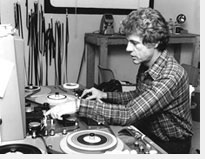

| Exhibition
| Chronology | Works
| Catalog
| Literature
| Press
| Trailer Visitor Information | Program | Partner | Credits | Deutsch |
|
James Blue  James Blue was an artist, film-maker, and teacher, and played a major role in renewing documentary film. His films are characterized by their social engagement. James Blue was an artist, film-maker, and teacher, and played a major role in renewing documentary film. His films are characterized by their social engagement. Following his study years in Paris, Blue went to Algeria in 1958. There he produced Les oliviers de la justice [The Olive Trees of Justice, 1962]: his sole feature film, and the only one to be filmed on the spot during the Algerian War. In choosing untrained actors and a highly realistic presentational mode, Blue positioned himself in relation to the idea of Cinéma Verité or Direct Cinema. Following that film came assignments for the United States Information Agency, for which he made five documentary films. The best known of these, The March [The March to Washington, 1963-64], presents the largest demonstration in American history: the black civil rights movementís protest march in 1963, culminating with Martin Luther Kingís famous speech. His later films also deal with grievances, however he increasingly agitates on the regional or communal level. Who Killed the Fourth Ward [1976] and The Invisible City [1979, made together with Adele Santos, now Dean of the School for Architecture and Planning at MIT] thematize miserable living conditions in the poor districts of Houston. Residents and those responsible speak out in interviews. In particular the multipartite documentary The Invisible City was conceived as a televised dialogue: its public could express themselves regarding its subject, and influence the concluding film. Blue did not just want to present problems, he wanted to make the mediatic freedom of television and film accessible to a broad public, and strengthen their sense of responsibility. His influential ideas with respect to documentary film were passed on, beginning in 1967 as the Director of the Media Center at Rice University in Houston, and then from 1977 onwards in the Department of Media Study at SUNY, Buffalo. |
|